- There have been 2,646 school shooting incidents in the U.S. since 1966. Of those, 2,205 (94%) occurred after the 1990 School Zone Safety Act (Amended in 1995). (Source)
- There are 1,325 total State Gun Laws per this 2022 report. (Source)
- The Federal government has been enacting Federal Firearm regulations since 1934.
- The correlation between population density and school shootings is more profound in population density than in firearm legislation.
- There is no standard “School shooting” definition in the U.S. The Secret Service defines targeted attacks, while most data includes incidents when a firearm is brandished, fired, or a bullet hits school property.
- There were 238 school shooting incidents during the National Assault Weapons ban, 293 in the decade before, and 347 in the decade after.
- 62% of school shootings (as defined) occurred during non-school hours (1970-2022).
- Firearms were used in 61% of targeted school attacks, and 39% used knives between 2008 & 2017.
On December 30, 1974, Anthony Barbaro walked into Olean High School in NY, killed 3 classmates, and injured 11 with a .30-06 rifle, 12 gauge shotgun, and smoke bombs. For more than 50 years, America’s school shootings have filled headlines around the world.
It’s tragic; people are tired of seeing the senseless loss of innocent lives in educational settings. Despite mounting gun control laws on the Federal and state level, school-related shootings continue to rise (2023 being the highest year yet, with 388 school shootings in only six months). Regardless of political affiliation or thoughts on well-regulated militias and the right to bear arms, one thing is clear; what we’ve been doing for the past forty years isn’t working.
Each school shooting incident in America reflects one thing, children are vulnerable. Schools tend to be easy targets while simultaneously producing mentally ill individuals with an unstoppable intent to harm others.
Unfortunately, we still have a lot to learn about school shootings. There are a lot of unanswered questions. But what we can do is investigate the changes between societal shifts and legislation over the years and spark meaningful conversations about stopping school shootings. Of course, the clock is ticking down to the next horrific headline, so we need to start these meaningful conversations now.
Getting to Know America’s Gun Laws
Thousands of federal and state gun laws are designed to keep firearms away from schools, out of the hands of the mentally ill, and inaccessible to minors. The vast majority of these laws were enacted in the 1980s and later.
However, school shootings have increased dramatically since the 1980s as well. To better understand what legislation we’re working with right now, let’s review the federal and state firearms laws on the books today.
Federal Gun Laws
With Congress and the White House working together, federal firearm legislation and restrictions are ample. Regardless of state or local legislation, these laws apply to any U.S. citizen. Although we don’t have an exact count of federal firearms laws (some resources cite 20,000 or more), we can pinpoint sweeping firearm legislation for the past 80 years and compare it to the rate of school shooting incidents for a broad picture of the effectiveness of federal firearms laws.
- National Firearms Act of 1934 – Limited weapon types
- Federal Firearms Act of 1938
- Gun Control Act of 1968
- 1986 Firearm Owners Protection Act
- 1990 Gun-Free School Zones Act – Amended (See Below)
- 1993 Brady Handgun Violence Prevention Act
- 1994 Federal Assault Weapons Ban
- Goals 2000 Education Act of 1994 – Any school that receives Federal funding must expel students for at least one year for bringing guns or knives to school.
- The Protection of Lawful Commerce in Arms Act & Child Safety Lock Act – 2005
- National Instant Criminal Background Check System Improvement Amendments Act – 2007
- The Bipartisan Safer Communities Act – 2022

(5.) United States v. Lopez – TX already had laws in place, but state charges against Alfonso Lopez were dropped when the Feds charged him. Congress amended the act to reflect firearms that traveled across state lines and cited undue financial hardship.
With school shooting-related incidents on the rise, politicians often over-exaggerate their role and power in protecting schools. President Biden signed the 2023 Executive Order on Reducing Gun Violence and Making Our Communities Safer. However, there are opponents of the School Zone Safety Act of 1990, and Rep. Massie recently introduced a bill to overturn it.
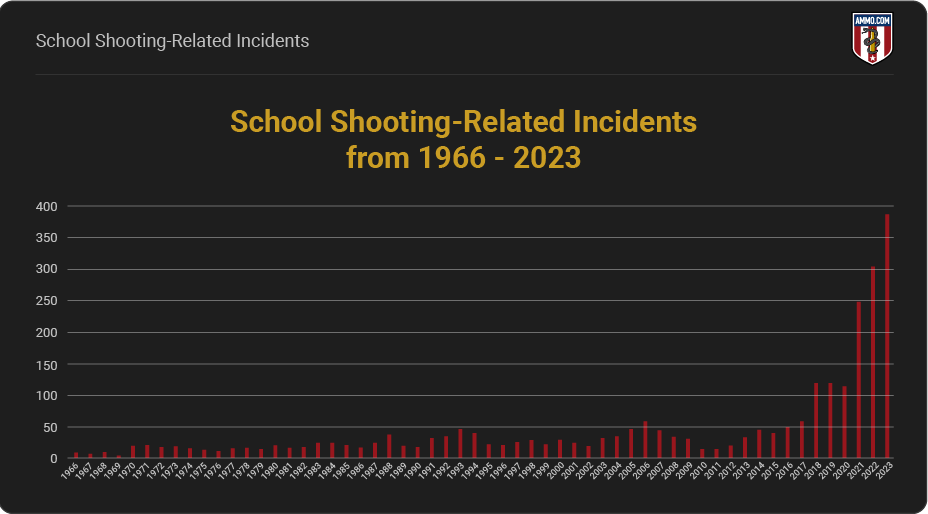
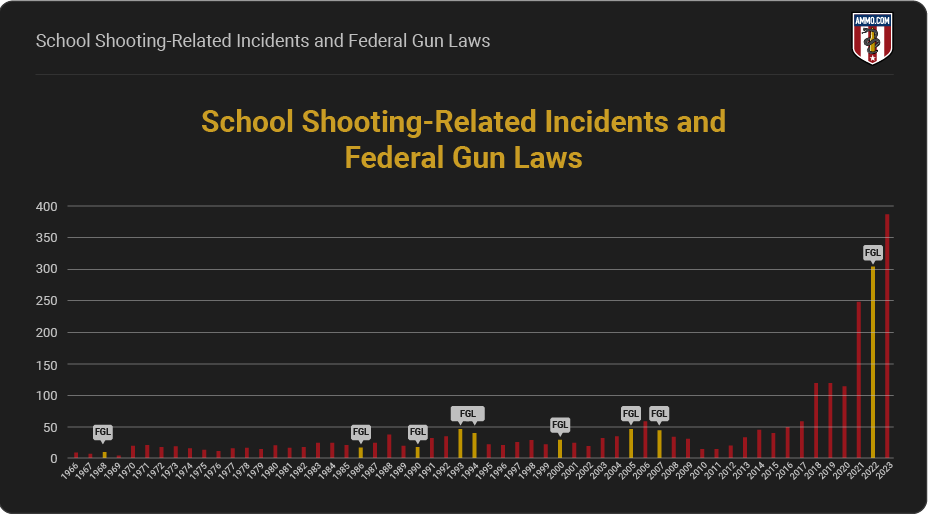
State-Level Gun Law Statistics
While all 50 states and Washington D.C. must adhere to strict federal firearm legislation, we must also examine how state laws impact school shooting incidents. Currently, there are 1,325 total state firearm laws countrywide. Each state has its own process for background checks, firearm purchases, carry and conceal regulations, and carry locations.
Seven states have outright open carry bans, eight require firearms registration, and fourteen have permit-to-purchase requirements. Unfortunately, in spite of legislation, American schools remain vulnerable to shooting incidents.
California has strict firearms laws but also has the highest number of school shooting-related incidents. On the contrary, Texas has a similar population size, relaxed firearms laws, and nearly as many school shooting incidents.
We’ve examined the top 9 states for school shootings and compared them with popular firearm legislation:

Targeted School Attacks
Targeted Attacks Highlights
- Students are targeted more often than faculty and SROs.
- Schools with fewer than 1,000 students have more targeted attacks than schools with more than 1,000 students.
- School attackers are more likely to be male than female.
- Suicidal ideations, disciplinary action, and retaliation are common precursors to an attack.
- Few schools have metal detection devices, and less than half of schools in America have armed School Resource Officers.
- The average targeted attack occurs after a seasonal break and lasts less than one minute.
- Most attackers get their firearms from a close friend or relative. Firearms are often obtained from unsecured locations.
- The majority of assailants obtained their weapons on the day of the attack.
Of the thousands of school shooting-related incidents in U.S. history, only a few were targeted attacks. We must explore targeted attacks to better understand what works and doesn’t work as it relates to keeping America’s children safe in the classroom. These incidents differ from others in that they’re highly publicized and often result in a massive loss of life.
Fortunately, the Secret Service and the Department of Education have studied school-targeted attacks (meaning the assailant targeted someone in the school, as opposed to the definition given above where a school was not necessarily the target).
Between 1974 and 2000, there were 37 targeted attacks committed by 41 individuals. 59% of those attacks occurred during the school day, 95% were committed by students, and 100% were males. 61% used handguns, and 54% targeted an administrator. Lastly, only ⅓ of attackers were receiving mental health assistance.
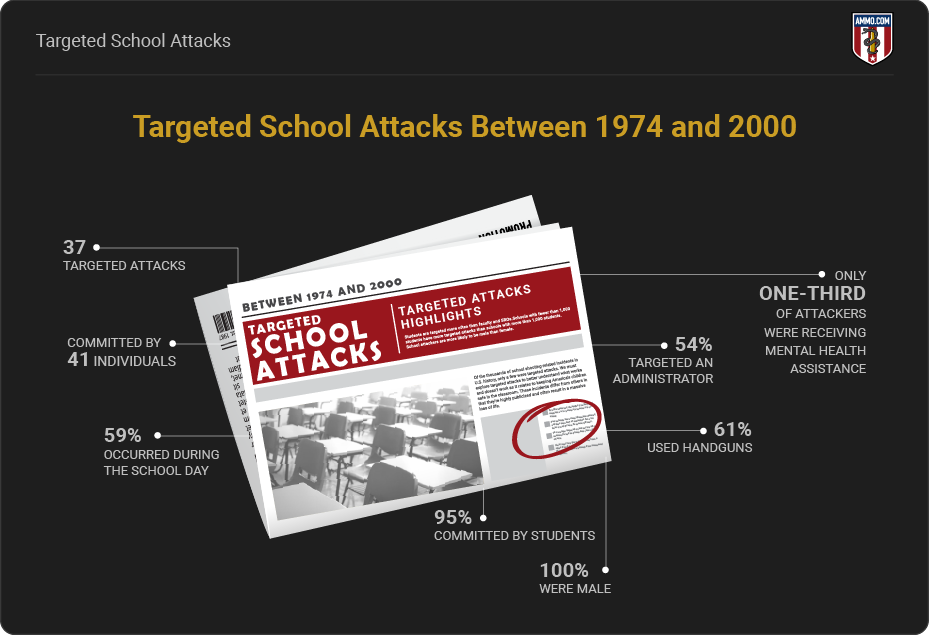
The Secret Service released another report regarding targeted attacks and schools for the 2008-2017 years.
Note: These attacks include knife and firearm statistics. The Secret Service defines a mass attack as one where three or more were injured. 24% of attacks in this study were mass attacks under that definition.
School Demographics
95% of targeted attacks happened at public schools. 34% were schools in suburban areas, 27% in urban areas, and 24% in rural areas.
Schools with fewer than 1,000 students comprised 59% of the total targeted attacks. 41% were schools with more than 1,000 students.
Targeted Attacks Highlights
- Targeted attacks occurred at a higher rate after seasonal breaks than at any other time. 24% of attacks occurred on the first day of school.
- 61% of attackers used firearms and 39% used knives.
- 51% of attacks happened during morning classroom hours.
- 51% of attackers stopped without external intervention. 17% committed suicide, and 15% left the scene.
- Students accounted for 85% of the victims in these incidents, while 13% were staff members, and 2% were SROs. In total, 79 people were injured, and 19 were killed in targeted attacks from 2008-2017.
- Twenty of the victims were stabbed, and the remaining were shot.
- Only one person was injured in the majority of these attacks (54%).
- 41% were motivated by suicide. 83% were retaliating against peers or staff.
School Security & Vulnerability
The implementation of school security guards and SROs (School Resource Officers with arresting authority and firearms) is also a hotly debated topic. Less than 46% of public schools in the U.S. have SROs. Many SROs cover more than one school.
7% of schools in this study had metal detectors (only 3). Six (15%) had unarmed security guards. 44% of the attacks lasted one minute. 83% lasted less than five minutes.
66% of these schools had full or part-time SRO; many SROs cover multiple school districts. However, the study did highlight that SROs’ response time is less than one minute, and outside law enforcement often responded within 5-10 minutes.
Acquisition of Firearm
51% of attackers in this study observably planned to carry out an attack. 76% of assailants obtained a weapon from a parent or close family member.
Less than half (48%) acquired firearms from an unsecured location. 16% acquired them from secure locations. Glass gun cabinets were often the most vulnerable location for firearm acquisition.
Understanding the Attacker
Many headlines speculate about one’s mental health before an attack on an educational institution. 63% of assailants from 2008 to 2017 had depression. 60% reported suicidal thoughts, 29% had anxiety, 26% had anger issues, and 20% had psychosis.
49% of the assailants had substance abuse issues. 46% of them had parents or siblings struggling with substance abuse. 71% had divorced parents, and 40% reported dysfunction in the family or domestic violence.
100% had social stressors within six months. Here are some of the more common characteristics of school attackers:
- 89% had disciplinary issues at school (i.e., suspension, poor grades, etc.)
- 80% expressed elicited concern from bystanders
- 83% shared verbal, written, video, or visual communications with threats
- 74% displayed anger outbursts or aggressive acts
- 71% stockpiled weapons
- 71% had an interest in weapons
- 63% depression and isolation
- 57% observable differences in appearance and behavior
- 54% expressed suicide and self-harm
- 37% had a heightened interest in violence
Gun Laws & Shootings by State
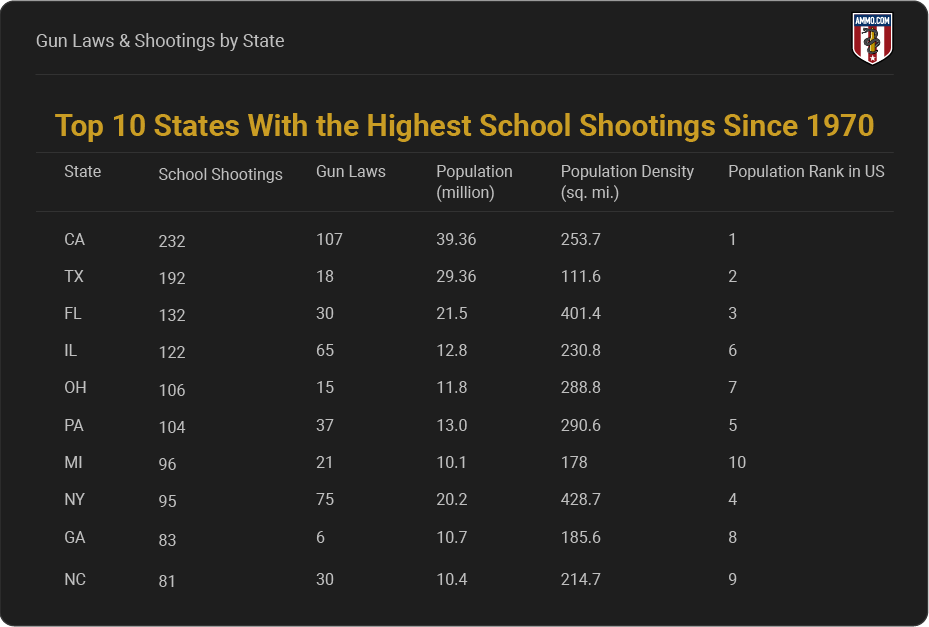
The top 10 states also have the top 10 populations. Population density has a stronger correlation with school-related shooting incidents than firearm ownership or legislation.
Sources
- Gun-Free School Zones Act of 1990
- Gun Laws by State
- State Gun Laws – 2020
- The effects of state and Federal Gun control laws on school shootings
- Licensing
- SRO Study
- Stats Before and After SROs


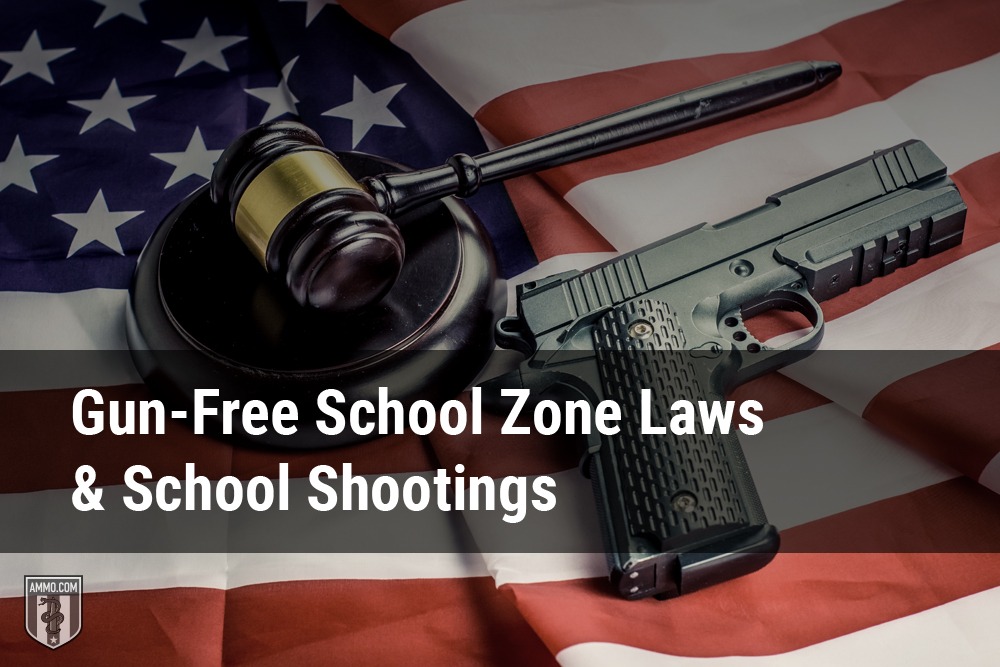




Why would anyone need a gun ?
Who is she pointing at?
Is there someone over my left shoulder?
My guess…most shootings happen within 20-30 miles of a military intelligence training base..where they practice “live fire” psyops on uS civilians…like all the Denver Colorado suburb shootings were.
I have always felt safer in areas I know the majority are most likely armed. Probably a false sense of security though.
Ugh. It’s Friday, which means FF clogs up everything, and the other threads are dead. I’m out. Have fun, y’all.
Will be in Florida for an event for a while so won’t be commenting. I’m not dead.
I always feel safer around white folks who aren’t cops and don’t do drugs.
Downtown Memphrica on Saturday night is full of armed people, but you would NOT be safe.
Surprising! I would’ve thought that the incidence of school shootings would go down per capita in pro-gun states, not stay similar. I would’ve liked to have seen a comparison of actual deaths in pro-gun states vs gun restricted states. My guess is there is a notable deviation there.
shootings follow local demographics, regardless of political dominance, i.e. black areas have high shooting rates regardless of being in new york or texas.
Niggers will be niggers.
We kept guns in our cars at schools even on gun racks in pickups. The uptick started at Columbine. I think it’s more tied to something else that’s generational. We had bullies, dealt with them and never ever thought of actually shooting someone else maybe kicking the shit out of them but not ending up in prison
Parents stopped raising their children.
Expected the schools to do it. They didn’t.
probably you are correct. I didn’t fear the cops or whatever near as much as my father. I got into a scuffle with him a little bit after I had left home and was on my own. But I was drunk and wish it never happened.
Check for activity of the ADL.
Meaningless statistics, except for one.
“62% of school shootings (as defined) occurred during non-school hours (1970-2022).”
I’ll give you a hint:
N
iggers
I
G
Nowhere does the author mention the enormous percentage of these shooters — and students generally — that are taking prescription psychotropic medications for such made-up conditions as ADHD, etc.
The statistical correlation between such medication use and school shootings or other violence has been demonstrated numerous times … so why does this author omit any discussion of it?
Because he’s not talking (mostly) about those school shootings. See the comment above yours to help.
If you mix the different kinds of “school shootings” the correlation you mentioned gets drowned out.
SSRIstories.org
selective serotonin reuptake inhibitors / class of anti-depressants / bad news
Yep.
Forget all that other crap. It’s the Anti-Psychotic drugs, Ritalin, Prozac and similar. It takes away impulse control, creates feelings of separation, and induces a perpetual state of rage in a certain percentage of people. It’s also hugely lucrative for the prescribing physician and big pharma.
nevermind method because broomsticks can be sharpened, rocks can be placed in socks, and then there’s good old hands-on, in addition to axes knives hammers other tools ,and finally firearms, instead, focus on the hate and hostility and mrcurial nature of teenage tempers. Young people typically dont have a lot of self-control, as a result they tend to fight more than adults. When gubetz decides to pacify rather than contructively direct and inform that anger, potentially explosive situations can result. All schools should have boxing class, maybe even karate class, where students can be informed about a lot of things including respect for other students, self-discipline and self-control, and working off pent-up energy in a less destructive way instead of just capping off rivals and gang actions.